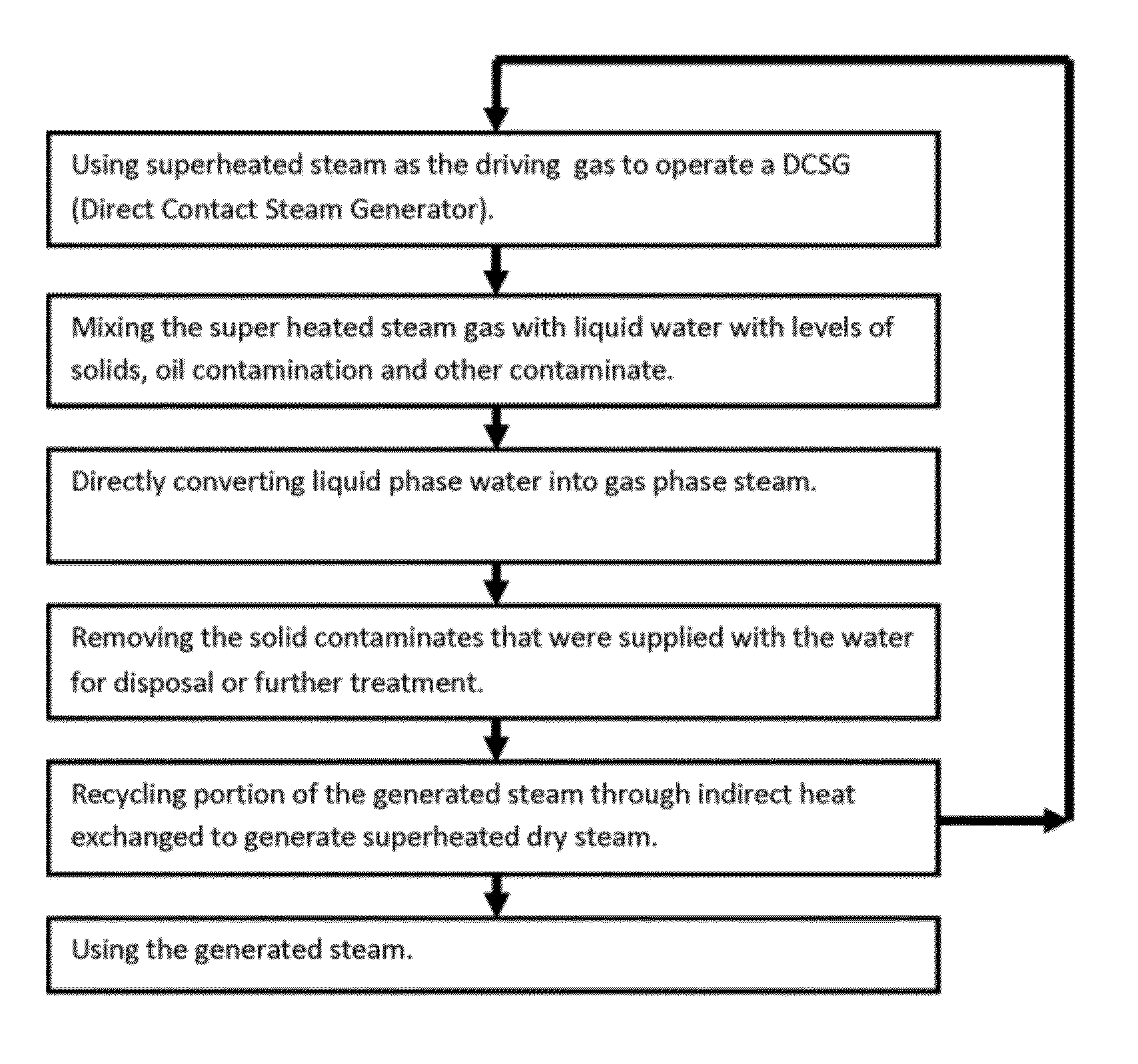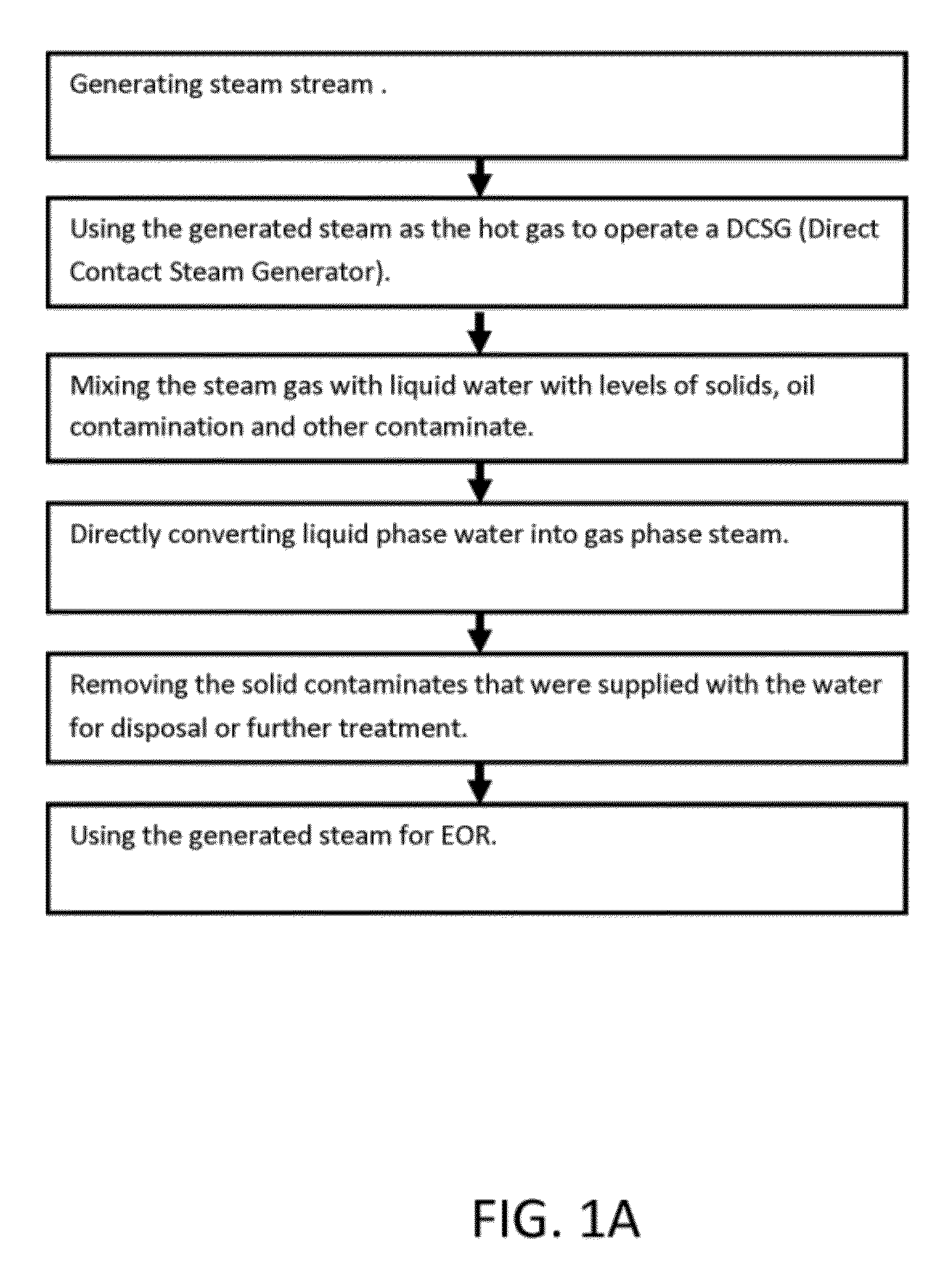Steam driven direct contact steam generation
a direct contact, steam generation technology, applied in the direction of tar working up by solvent extraction, fluid removal, insulation, etc., can solve the problems of existing steam generation methods and decrease achieve the effect of reducing the overall efficiency of sagd, efficient de-oiled, and high water quality
- Summary
- Abstract
- Description
- Claims
- Application Information
AI Technical Summary
Benefits of technology
Problems solved by technology
Method used
Image
Examples
example 2
[0155]The graph in FIG. 23 simulates the process as described in FIG. 2A. The driving steam 2A.9 temperature was constant at 450° C. The liquid water 2A.7 was at temperature of 25° C. and had a constant flow of 1000 kg / hour. The produced steam product or produced gas 2A.8 was saturated. The graph shows the amount of drive steam 2A.9 required to transfer the liquid water 2A.7 into the gas phase as a function of the pressure of the driving steam 2A.9. When the system pressure was 2 bar, 3.87 tons / hour of driving steam was needed to convert the water to saturated steam at temperature of 121° C. For a 50 bar system pressure, 5.14 tons / hour of driving steam was used to generate saturated steam at 256° C. The simulation results are summarized in the following table:
[0156]
Temperature DrivingSystem of SaturatedSteam PressureproducedFlow(bar)Steam(kg / hr)100.00311.825127.9475.00291.355161.7850.00264.745135.6625.00224.704914.4620.00 213.114821.4215.00198.984696.4110.00180.534515.835.00152.4042...
example 3
[0157]The graph in FIG. 24 simulates the process as described in FIG. 2A where the water feed includes solids and naphtha. As the pressure increases, the saturated temperature of the steam also increases from around 100 C at 1 bar to around 312 C 100 bar. Thus, the amount of superheated steam input at 450 C also increases from around 2300 kg / hr to 4055 kg / hr. The graph in FIG. 24 represents the superheated driving steam input or dry steam 2A.9 and the total flow rate (including hydrocarbons) of the produced gas 2A.8.
[0158]
Flow Number79128T, C25.00450.00120.61120.61P, atm2.002.002.002.00Vapor Fraction0.001.000.001.00Enthalpy, MJ−14885.08−29133.36−6692.49−37325.62Total Flow, kg / hr1000.002311.54414.732896.81Water600.002311.54114.202797.34Solids300.000.00300.004.14E−17Naptha100.000.000.5399.47
example 4
[0159]The following table simulates the process as described in FIG. 3 for insitue oilsands thermal extraction facilities, like SAGD, for two different pressures. The water feed is hot produced water at 200 C that includes solids and bitumen. The heat source Q′ for the simulation was 12 KW.
[0160]For a system pressure of 400 psi the total Inflow of water, solids and bitumen of flow and water feed 3.34 was 23.4 kg. 77% of the steam 3.31 is recycled as the driving steam 3.32 while 23% is discharged out of system at 283 C steam and hydrocarbons.
[0161]For a system pressure of 600 psi, the total Inflow of water, solids, and Bitumen of flow and water feed 3.34 was 22.5 kg. 80% of the steam 3.31 is recycled as the driving steam 3.32 while 20% is discharged out of system at 283 C steam and hydrocarbons.
[0162]
Flow Number343531323633T, C.200243.42243.42243.43486.73243.43Press., psig400400400400400.00400.00Vapor Fraction00.001.001.001.001.00Enthalpy, kW−96.591−5.06−346.24−266.80−254.78−79.69Tot...
PUM
 Login to View More
Login to View More Abstract
Description
Claims
Application Information
 Login to View More
Login to View More - R&D
- Intellectual Property
- Life Sciences
- Materials
- Tech Scout
- Unparalleled Data Quality
- Higher Quality Content
- 60% Fewer Hallucinations
Browse by: Latest US Patents, China's latest patents, Technical Efficacy Thesaurus, Application Domain, Technology Topic, Popular Technical Reports.
© 2025 PatSnap. All rights reserved.Legal|Privacy policy|Modern Slavery Act Transparency Statement|Sitemap|About US| Contact US: help@patsnap.com



